The box tree moth, Cydalima perspectalis (Fig. 1) is an invasive pest of boxwood (Buxus spp.). It was introduced in New York in 2021 and is now reported in Michigan, Ohio, Connecticut, Massachusetts, New York, and South Carolina—and a distribution center in Tennessee. It is not reported in Georgia. The native range of box tree moth is in Asia, including Japan, China, Korea, and India. This pest is reported as a serious problem in Canada, Europe, and Russia. Boxwoods are an important ornamental evergreen shrub in the southeastern US that is widely planted in residential, commercial, and public landscapes in urban areas.
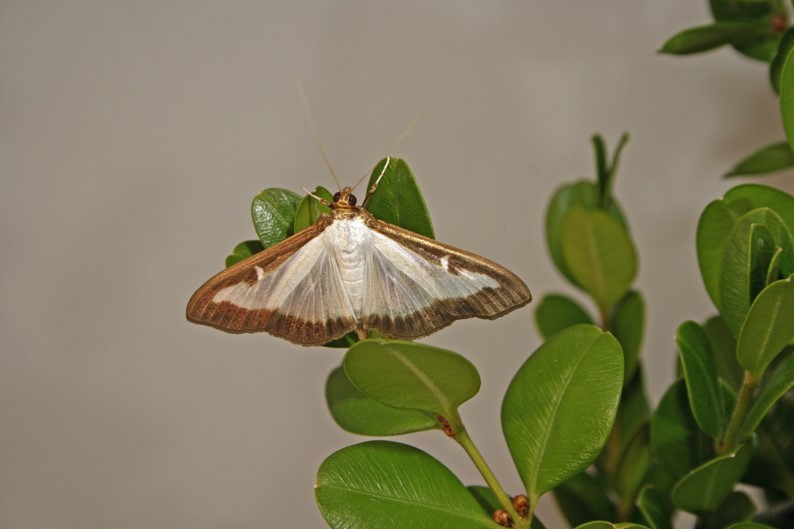
Description and life history
Adult box tree moths are mostly white, with a white comma on each forewing. The head, borders of wings, and tips of the abdomen are brown (Fig. 1). However, approximately 10% of the moths are entirely brown with a comma-shaped mark on both forewings (Fig. 1). Their wingspan is 1.6 to 1.8 inches wide with a slight iridescence. Adults can live up to 30 days and spread over a radius of approximately six miles. They lay translucent, flat, yellowish eggs in 5-10 eggs on the leaf surface (Fig. 2). These eggs appear as fish scales on a surface. The eggs hatch within 3-4 days, depending on local temperature. The neonates of the box tree moth are pale brown with a black head (Fig. 3). The late instars are green with black and yellow stripes and black spots (Figs. 4 and 5). The head of the late instars of box tree moth caterpillar is black. They feed on the leaves for up to two weeks and pupate in silken webbing and leaves. The young pupa appears green with brown stripes (Fig. 6). After approximately two weeks, the moths eclose from the pupae.
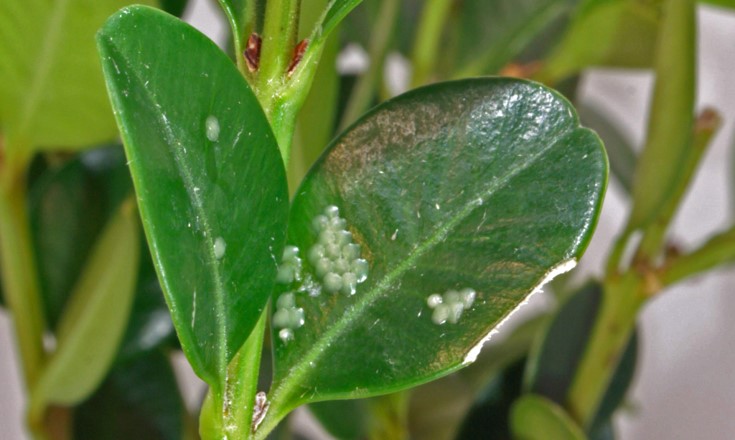
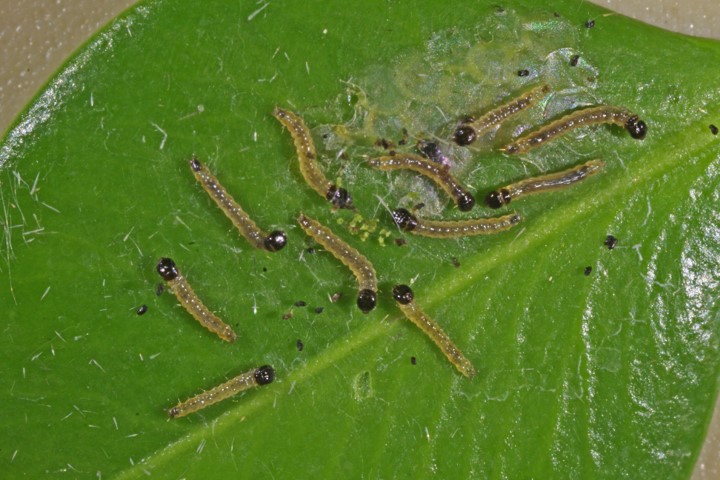
Box tree moths overwinter as larvae in silken chambers built between leaves. As the weather warms in the spring, they emerge from the silken chambers and feed on leaves before pupating in the silk chamber. Multiple generations are possible as all stages may be present throughout the summer. There could be up to five generations per year. The overwintering caterpillars can tolerate temperatures as low as -22 °F and resume development when temperatures reach approximately 46 °F in the spring.
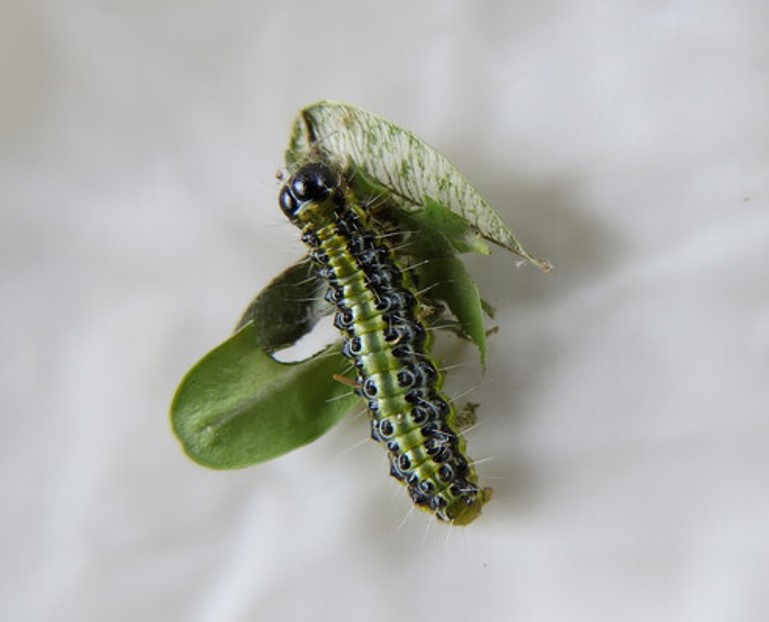


Host plants
Boxwoods (Buxus spp.)
Damage
Extensive feeding of larval stages causes defoliation of boxwoods (Figs. 7, 8, and 9). The young instars scrape off the tissues from the underside of the foliage. The affected leaves appear bleached. As they grow into bigger caterpillars, they can eat the entire leaves but the midrib. Caterpillars produce extensive webbing on the foliage. When leaves are all defoliated, the larvae feed on the bark. Heavy infestations can cause plant death.

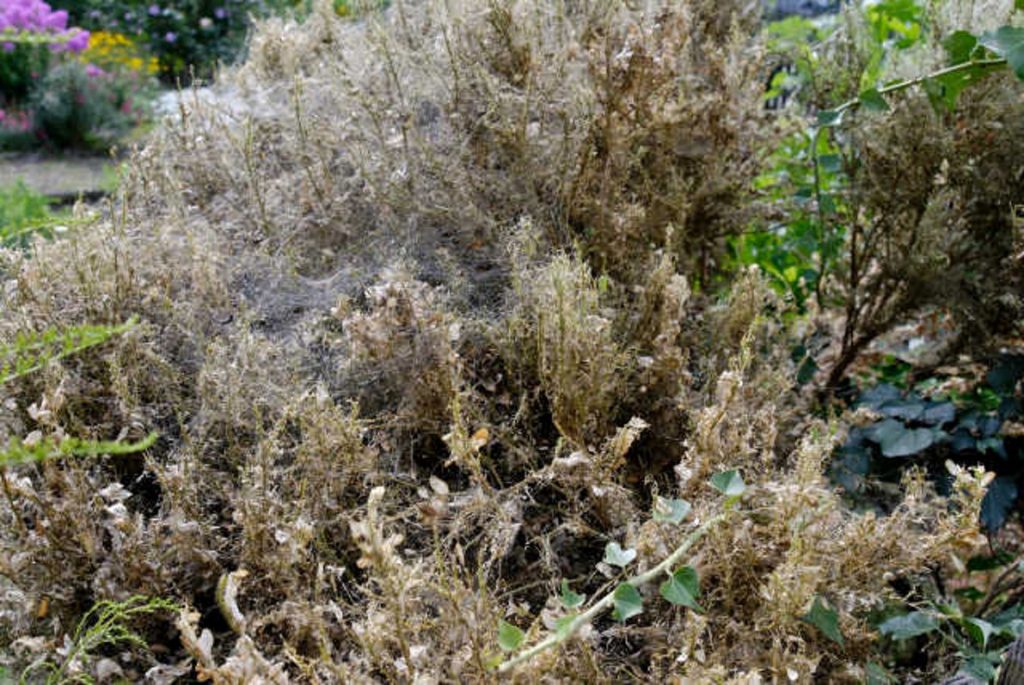
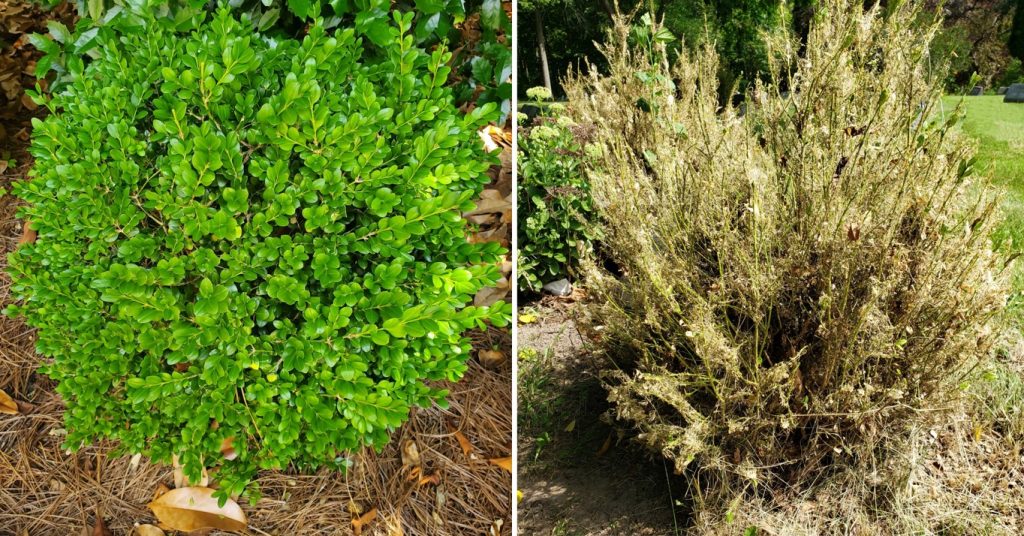
Management
After initial confirmation in Germany, boxtree moth spread rapidly to most European countries in the last ten years through the movement of native boxwood species. In the USA, European boxwood cultivars are favored by the landscape industry and actively planted in new residential and commercial developments, and widely grown in container nurseries. Boxwood materials are actively moved around in the USA and can likely contribute to this invasive pest’s spread. Because boxwood plants are not native to the USA, it is not present in natural wild habitats, suggesting the spread could be restricted.
Contact insecticides, such as pyrethroids (e.g., permethrin, cyfluthrin, deltamethrin, bifenthrin) or spinosad, should be effective against larval stages. Multiple applications during the growing season may be necessary. Bacillus thuringiensis subsp. kurstaki (Btk), widely recommended for caterpillar pest management, should be effective against early instars of box tree moth. Multiple weekly applications should be required for effective management using Btk products.
What should I do if an infestation is suspected?
If you suspect a box tree moth infestation or damage, please collect a few moths, contact a local Extension agent or Georgia Department of Agriculture, and send the specimens for confirmation.
References
Bras, A., D. N. Avtzis, M. Kenis, H. Li, G. Vétek, A. Bernard, C. Courtin, J. Rousselet, A. Roques, and M.-A. Auger-Rozenberg. 2019. A complex invasion story underlies the fast spread of the invasive box tree moth (Cydalima perspectalis) across Europe. Journal of Pest Science, 92: 1187–1202.
(EBTS) European Boxwood & Topiary Society. 2020. Box tree moth & caterpillar. Available online.
Larson, J. L. 2022. Box tree moth – invasive pest of boxwoods. ENTFACT-464. Martin-Gatton College of Agriculture, Food and Environment. https://entomology.ca.uky.edu/ef464
Leeser, J., and B. Eshenaur. 2023. Box tree moth. New York State Integrated Pest Management, Cornell University https://cals.cornell.edu/new-york-state-integrated-pest-management/outreach-education/fact-sheets/box-tree-moth
Strachinis, I., C. Kazilas, F. Karamaouna, N. E. Papanikolaou, G. K. Partsinevelos, and P. G. Milonas. 2015. First record of Cydalima perspectalis (Walker, 1859) (Lepidoptera: Crambidae) in Greece. Hellenic Plant Protection Journal, 8: 66–72.
Skvarla, M. J. 2023. Box tree moth. https://extension.psu.edu/box-tree-moth
Wan, H. T. Hays, M. Kenis, S. Nacambo, H. Xu, F. Zhang, and H. Li. 2014. Biology and natural enemies of Cydalima perspectalis in Asia: Is there biological control potential in Europe? Journal of Applied Entomology, 138: 715–722.